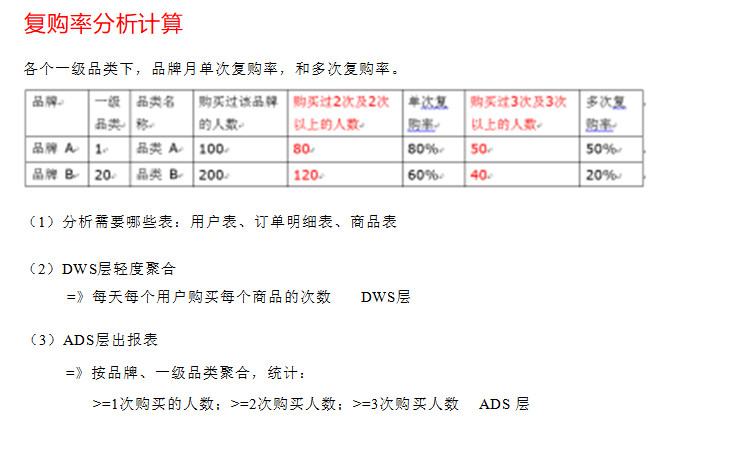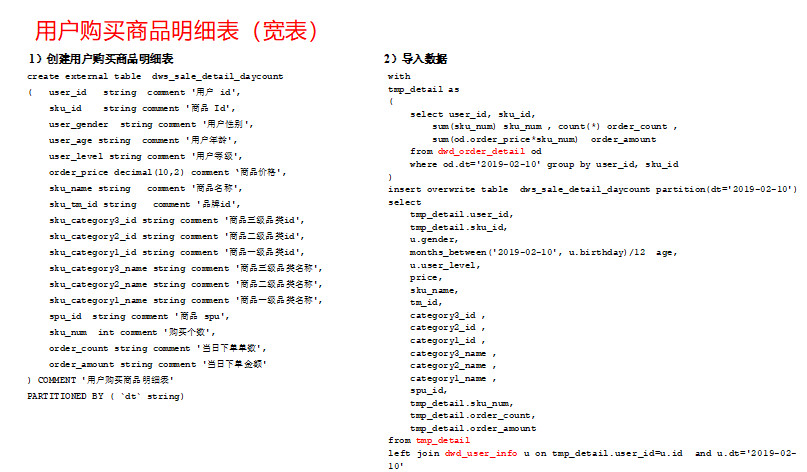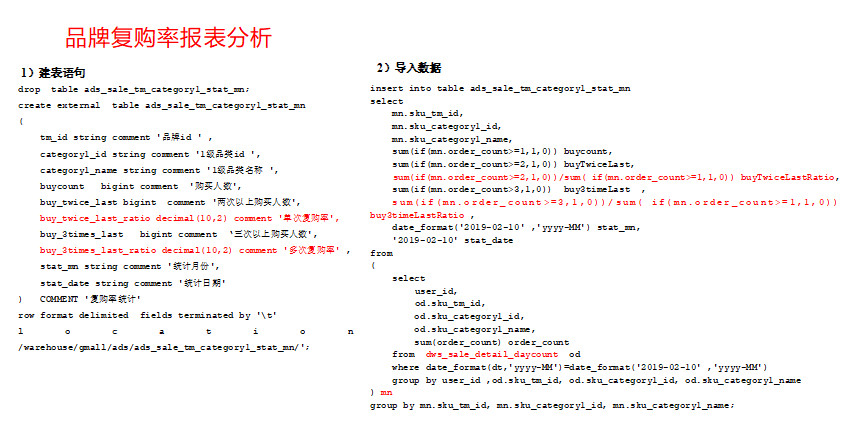问题导读:
1、如何以月为单位统计,购买2次以上商品的用户?
2、如何设计用户购买商品明细表(宽表)?
3、如何统计各用户等级对应的复购率前十的商品排行?
4、如何统计每等级用户每产品的下单次数?
上一篇:大数据项目之电商数仓(总结)(四):系统业务数据仓库
第6章 需求三:品牌复购率
需求:以月为单位统计,购买2次以上商品的用户
6.1 复购率计算分析

6.2 DWS层
6.2.1 用户购买商品明细表(宽表)

- hive (gmall)>
- drop table if exists dws_sale_detail_daycount;
- create external table dws_sale_detail_daycount
- (
- user_id string comment '用户 id',
- sku_id string comment '商品 Id',
- user_gender string comment '用户性别',
- user_age string comment '用户年龄',
- user_level string comment '用户等级',
- order_price decimal(10,2) comment '商品价格',
- sku_name string comment '商品名称',
- sku_tm_id string comment '品牌id',
- sku_category3_id string comment '商品三级品类id',
- sku_category2_id string comment '商品二级品类id',
- sku_category1_id string comment '商品一级品类id',
- sku_category3_name string comment '商品三级品类名称',
- sku_category2_name string comment '商品二级品类名称',
- sku_category1_name string comment '商品一级品类名称',
- spu_id string comment '商品 spu',
- sku_num int comment '购买个数',
- order_count string comment '当日下单单数',
- order_amount string comment '当日下单金额'
- ) COMMENT '用户购买商品明细表'
- PARTITIONED BY (`dt` string)
- stored as parquet
- location '/warehouse/gmall/dws/dws_user_sale_detail_daycount/'
- tblproperties ("parquet.compression"="snappy");
6.2.2 数据导入
- hive (gmall)>
- with
- tmp_detail as
- (
- select
- user_id,
- sku_id,
- sum(sku_num) sku_num,
- count(*) order_count,
- sum(od.order_price*sku_num) order_amount
- from dwd_order_detail od
- where od.dt='2019-02-10'
- group by user_id, sku_id
- )
- insert overwrite table dws_sale_detail_daycount partition(dt='2019-02-10')
- select
- tmp_detail.user_id,
- tmp_detail.sku_id,
- u.gender,
- months_between('2019-02-10', u.birthday)/12 age,
- u.user_level,
- price,
- sku_name,
- tm_id,
- category3_id,
- category2_id,
- category1_id,
- category3_name,
- category2_name,
- category1_name,
- spu_id,
- tmp_detail.sku_num,
- tmp_detail.order_count,
- tmp_detail.order_amount
- from tmp_detail
- left join dwd_user_info u on tmp_detail.user_id =u.id and u.dt='2019-02-10'
- left join dwd_sku_info s on tmp_detail.sku_id =s.id and s.dt='2019-02-10';
6.2.3 数据导入脚本
1)在/home/kgg/bin目录下创建脚本dws_sale.sh
- [kgg@hadoop102 bin]$ vim dws_sale.sh
- 在脚本中填写如下内容
- #!/bin/bash
-
- # 定义变量方便修改
- APP=gmall
- hive=/opt/module/hive/bin/hive
-
- # 如果是输入的日期按照取输入日期;如果没输入日期取当前时间的前一天
- if [ -n "$1" ] ;then
- do_date=$1
- else
- do_date=`date -d "-1 day" +%F`
- fi
-
- sql="
-
- set hive.exec.dynamic.partition.mode=nonstrict;
-
- with
- tmp_detail as
- (
- select
- user_id,
- sku_id,
- sum(sku_num) sku_num,
- count(*) order_count,
- sum(od.order_price*sku_num) order_amount
- from "$APP".dwd_order_detail od
- where od.dt='$do_date'
- group by user_id, sku_id
- )
- insert overwrite table "$APP".dws_sale_detail_daycount partition(dt='$do_date')
- select
- tmp_detail.user_id,
- tmp_detail.sku_id,
- u.gender,
- months_between('$do_date', u.birthday)/12 age,
- u.user_level,
- price,
- sku_name,
- tm_id,
- category3_id,
- category2_id,
- category1_id,
- category3_name,
- category2_name,
- category1_name,
- spu_id,
- tmp_detail.sku_num,
- tmp_detail.order_count,
- tmp_detail.order_amount
- from tmp_detail
- left join "$APP".dwd_user_info u
- on tmp_detail.user_id=u.id and u.dt='$do_date'
- left join "$APP".dwd_sku_info s on tmp_detail.sku_id =s.id and s.dt='$do_date';
-
- "
- $hive -e "$sql"
2)增加脚本执行权限
- [kgg@hadoop102 bin]$ chmod 777 dws_sale.sh
3)执行脚本导入数据
- [kgg@hadoop102 bin]$ dws_sale.sh 2019-02-11
4)查看导入数据
- hive (gmall)>
- select * from dws_sale_detail_daycount where dt='2019-02-11' limit 2;
6.3 ADS层品牌复购率

6.3.1 建表语句
- hive (gmall)>
- drop table ads_sale_tm_category1_stat_mn;
- create external table ads_sale_tm_category1_stat_mn
- (
- tm_id string comment '品牌id',
- category1_id string comment '1级品类id ',
- category1_name string comment '1级品类名称 ',
- buycount bigint comment '购买人数',
- buy_twice_last bigint comment '两次以上购买人数',
- buy_twice_last_ratio decimal(10,2) comment '单次复购率',
- buy_3times_last bigint comment '三次以上购买人数',
- buy_3times_last_ratio decimal(10,2) comment '多次复购率',
- stat_mn string comment '统计月份',
- stat_date string comment '统计日期'
- ) COMMENT '复购率统计'
- row format delimited fields terminated by '\t'
- location '/warehouse/gmall/ads/ads_sale_tm_category1_stat_mn/';
6.3.2 数据导入
1)数据导入
- hive (gmall)>
- insert into table ads_sale_tm_category1_stat_mn
- select
- mn.sku_tm_id,
- mn.sku_category1_id,
- mn.sku_category1_name,
- sum(if(mn.order_count>=1,1,0)) buycount,
- sum(if(mn.order_count>=2,1,0)) buyTwiceLast,
- sum(if(mn.order_count>=2,1,0))/sum( if(mn.order_count>=1,1,0)) buyTwiceLastRatio,
- sum(if(mn.order_count>=3,1,0)) buy3timeLast ,
- sum(if(mn.order_count>=3,1,0))/sum( if(mn.order_count>=1,1,0)) buy3timeLastRatio ,
- date_format('2019-02-10' ,'yyyy-MM') stat_mn,
- '2019-02-10' stat_date
- from
- (
- select
- user_id,
- sd.sku_tm_id,
- sd.sku_category1_id,
- sd.sku_category1_name,
- sum(order_count) order_count
- from dws_sale_detail_daycount sd
- where date_format(dt,'yyyy-MM')=date_format('2019-02-10' ,'yyyy-MM')
- group by user_id, sd.sku_tm_id, sd.sku_category1_id, sd.sku_category1_name
- ) mn
- group by mn.sku_tm_id, mn.sku_category1_id, mn.sku_category1_name;
2)查询导入数据
- hive (gmall)> select * from ads_sale_tm_category1_stat_mn;
6.3.3 数据导入脚本
1)在/home/kgg/bin目录下创建脚本ads_sale.sh
- [kgg@hadoop102 bin]$ vim ads_sale.sh
- 在脚本中填写如下内容
- #!/bin/bash
-
- # 定义变量方便修改
- APP=gmall
- hive=/opt/module/hive/bin/hive
-
- # 如果是输入的日期按照取输入日期;如果没输入日期取当前时间的前一天
- if [ -n "$1" ] ;then
- do_date=$1
- else
- do_date=`date -d "-1 day" +%F`
- fi
-
- sql="
-
- set hive.exec.dynamic.partition.mode=nonstrict;
-
- insert into table "$APP".ads_sale_tm_category1_stat_mn
- select
- mn.sku_tm_id,
- mn.sku_category1_id,
- mn.sku_category1_name,
- sum(if(mn.order_count>=1,1,0)) buycount,
- sum(if(mn.order_count>=2,1,0)) buyTwiceLast,
- sum(if(mn.order_count>=2,1,0))/sum( if(mn.order_count>=1,1,0)) buyTwiceLastRatio,
- sum(if(mn.order_count>=3,1,0)) buy3timeLast,
- sum(if(mn.order_count>=3,1,0))/sum( if(mn.order_count>=1,1,0)) buy3timeLastRatio ,
- date_format('$do_date' ,'yyyy-MM') stat_mn,
- '$do_date' stat_date
- from
- (
- select
- user_id,
- od.sku_tm_id,
- od.sku_category1_id,
- od.sku_category1_name,
- sum(order_count) order_count
- from "$APP".dws_sale_detail_daycount od
- where date_format(dt,'yyyy-MM')=date_format('$do_date' ,'yyyy-MM')
- group by user_id, od.sku_tm_id, od.sku_category1_id, od.sku_category1_name
- ) mn
- group by mn.sku_tm_id, mn.sku_category1_id, mn.sku_category1_name;
-
- "
- $hive -e "$sql"
2)增加脚本执行权限
- [kgg@hadoop102 bin]$ chmod 777 ads_sale.sh
3)执行脚本导入数据
- [kgg@hadoop102 bin]$ ads_sale.sh 2019-02-11
4)查看导入数据
- hive (gmall)>
- select * from ads_sale_tm_category1_stat_mn limit 2;
第7章 需求四:各用户等级对应的复购率前十的商品排行
7.1 DWS层
使用用户购买明细表宽表(dws_sale_detail_daycount)作为DWS数据
7.2 ADS层
7.2.1 建表语句
- drop table ads_ul_rep_ratio;
- create table ads_ul_rep_ratio(
- user_level string comment '用户等级' ,
- sku_id string comment '商品id',
- buy_count bigint comment '购买总人数',
- buy_twice_count bigint comment '两次购买总数',
- buy_twice_rate decimal(10,2) comment '二次复购率',
- rank string comment '排名' ,
- state_date string comment '统计日期'
- ) COMMENT '复购率统计'
- row format delimited fields terminated by '\t'
- location '/warehouse/gmall/ads/ads_ul_rep_ratio/';
7.2.2 导入数据
- with
- tmp_count as(
- select -- 每个等级内每个用户对每个产品的下单次数
- user_level,
- user_id,
- sku_id,
- sum(order_count) order_count
- from dws_sale_detail_daycount
- where dt<='2019-10-05'
- group by user_level, user_id, sku_id
- )
- insert overwrite table ads_ul_rep_ratio
- select
- *
- from(
- select
- user_level,
- sku_id,
- sum(if(order_count >=1, 1, 0)) buy_count,
- sum(if(order_count >=2, 1, 0)) buy_twice_count,
- sum(if(order_count >=2, 1, 0)) / sum(if(order_count >=1, 1, 0)) * 100 buy_twice_rate,
- row_number() over(partition by user_level order by sum(if(order_count >=2, 1, 0)) / sum(if(order_count >=1, 1, 0)) desc) rn,
- '2019-10-05'
- from tmp_count
- group by user_level, sku_id
- ) t1
- where rn<=10
7.2.2 导入数据脚本
1)在/home/kgg/bin目录下创建脚本ads_ul_rep_ratio.sh
- [kgg@hadoop102 bin]$ vim ads_ul_rep_ratio.sh
- 在脚本中填写如下内容
- #!/bin/bash
-
- db=gmall
- hive=/opt/module/hive-1.2.1/bin/hive
- hadoop=/opt/module/hadoop-2.7.2/bin/hadoop
-
- if [[ -n $1 ]]; then
- do_date=$1
- else
- do_date=`date -d '-1 day' +%F`
- fi
-
- sql="
- use gmall;
- with
- tmp_count as(
- select -- 每等级用户每产品的下单次数
- user_level,
- sku_id,
- sum(order_count) order_count
- from dws_sale_detail_daycount
- where dt<='$do_date'
- group by user_level, sku_id
- )
- insert overwrite table ads_ul_rep_ratio
- select
- *
- from(
- select
- user_level,
- sku_id,
- sum(if(order_count >=1, 1, 0)) buy_count,
- sum(if(order_count >=2, 1, 0)) buy_twice_count,
- sum(if(order_count >=2, 1, 0)) / sum(if(order_count >=1, 1, 0)) * 100 buy_twice_rate,
- row_number() over(partition by user_level order by sum(if(order_count >=2, 1, 0)) / sum(if(order_count >=1, 1, 0)) desc) rn,
- '$do_date'
- from tmp_count
- group by user_level, sku_id
- ) t1
- where rn<=10
- "
-
- $hive -e "$sql"
2)增加脚本执行权限
- [kgg@hadoop102 bin]$ chmod 777 ads_user_total_count.sh
3)脚本使用
- [kgg@hadoop102 module]$ ads_user_total_count.sh 2019-02-20
4)查询结果
- hive (gmall)> select * from ads_user_total_count;
5)脚本执行时间
复制代码
最新经典文章,欢迎关注公众号
|
 /2
/2 